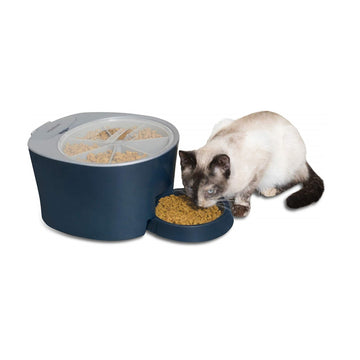When you live with multiple pets, mealtime can be a challenge. How do you feed different foods to multiple animals without them gulping from each other's bowls? Even worse, what can be done to manage and prevent squabbles over the smorgasbord?
How Cats Eat
 Besides nutritional differences, cats and dogs also eat and process food differently. Cats tend to nibble by themselves, and prefer about five mouse-size meals throughout the day. Cats also prefer foods at "prey body temperature" and refrigerated leftovers can be off-putting unless warmed up before re-serving. Cats don't seem to get nearly as competitive over food as dogs do, perhaps because they are more likely to eat alone, and because it takes less food to satisfy that one-meal mentality. Since cats developed to eat animals, they don't have a typical sweet tooth. Instead, cats detect a sort of "meaty-sweet" flavor found in animal protein. When they leave food behind, that's tempting for dogs to clean up after them.
Besides nutritional differences, cats and dogs also eat and process food differently. Cats tend to nibble by themselves, and prefer about five mouse-size meals throughout the day. Cats also prefer foods at "prey body temperature" and refrigerated leftovers can be off-putting unless warmed up before re-serving. Cats don't seem to get nearly as competitive over food as dogs do, perhaps because they are more likely to eat alone, and because it takes less food to satisfy that one-meal mentality. Since cats developed to eat animals, they don't have a typical sweet tooth. Instead, cats detect a sort of "meaty-sweet" flavor found in animal protein. When they leave food behind, that's tempting for dogs to clean up after them.
How Dogs Eat
Meanwhile, dogs tend to gulp bowlfuls, consider meals a community event, and may skip a day now and then after gorging. The dog that finishes first naturally wants what's in his doggy friend's bowl, and that can prompt squabbles. Canines are group-oriented creatures that consider mealtime a social event, and want to eat with their pack--including the cat. Group meals can lead to competition for the bowl, though. Dogs often eat more food when in the company of other dogs or family members, probably because of a perceived notion of competition--"I'll eat it so SHE doesn't get it!" mentality.
Dogs inherited the glutton gene from ancestors that hunted in packs able to kill large animals, which provided them with massive amounts of food. The rule was to eat it all or risk having interlopers steal the leftovers. Many dogs don't chew; they grab and swallow mouthfuls until they empty the bowl. They also have a sweet tooth because they are omnivores and need to tell when fruits and vegetables ripen.
Even cat and dog bodies process food at different rates. It takes twenty-four hours from eating a meal for the dog to fully process the food, but the same sequences only takes about thirteen hours in the cat. (It can take up to fifty-six hours in people.) Because their digestive systems work differently, cats and dogs need to eat on different schedules.
8 Tips to Calm Dinnertime Angst
When you share your home with multiple pets, you must manage meals to account for individual living circumstances and the very different needs and social interactions of the pets. If your cats and dogs eat only from their assigned bowls, count your blessings! But to keep the pets from eating from from each other's bowl, here are some tips. Not all will work for every circumstance so please use those that work best for your furry crew.
- Give each pet their own bowls, to accommodate the different foods each eat.
- Scheduled two or three meals a day, so your pets can anticipate the routine. Meal feeding is healthier for pets and allows you to better monitor who eats what, and make adjustments if necessary.
- Assign each pet a specific place to eat. In that way, the food bowl and surrounding area becomes the "owned" property of a specific dog, for instance, so the other pets may be more willing to respect the territorial claim.
- Stagger feeding times. Most pets eat all they want within ten to twenty minutes, and scheduled times even 10 minutes apart help you more easily supervise each meal and keep multiple pets from snitching food from each other's bowls.
- Create a 'boxed lunch' when the pets vary greatly in size, to give the smallest a private dining area. Cut a tiny opening in a clear plastic storage container that's only big enough for the little guy to get through, while the bigger animal can't access. Place the small pet's food bowl inside the box to nibble at his leisure. The clear plastic also lets the pet see out and avoid being ambushed.
- Place the cat's bowls out of reach of nosy dogs to reduce competition and keep all the critters happy. Felines prefer elevated spots such as countertops, cat trees or the washing machine top, and are less likely to graze from floor-level bowls when they can dine on high.
- Feed your pets in different rooms, or use a baby gate to segregate hallways or stairways to create separate feeding areas, when you don't have enough rooms.
- Feed using puzzle toys. The cat's puzzles can be placed inside cat tunnels or on top of cat trees to keep the dog away. Puzzles keep the pets "hunting" rather than scrounging from each other's bowls.




